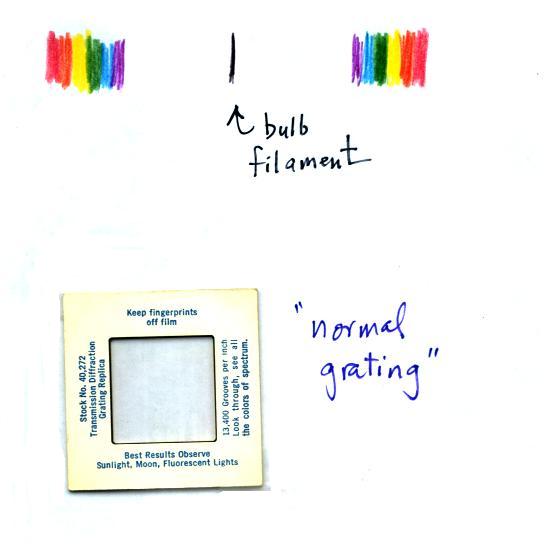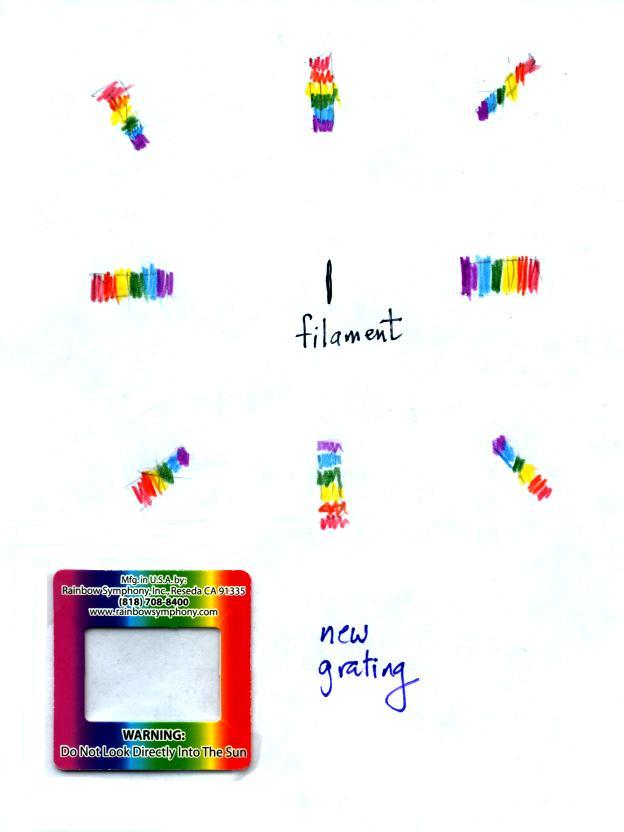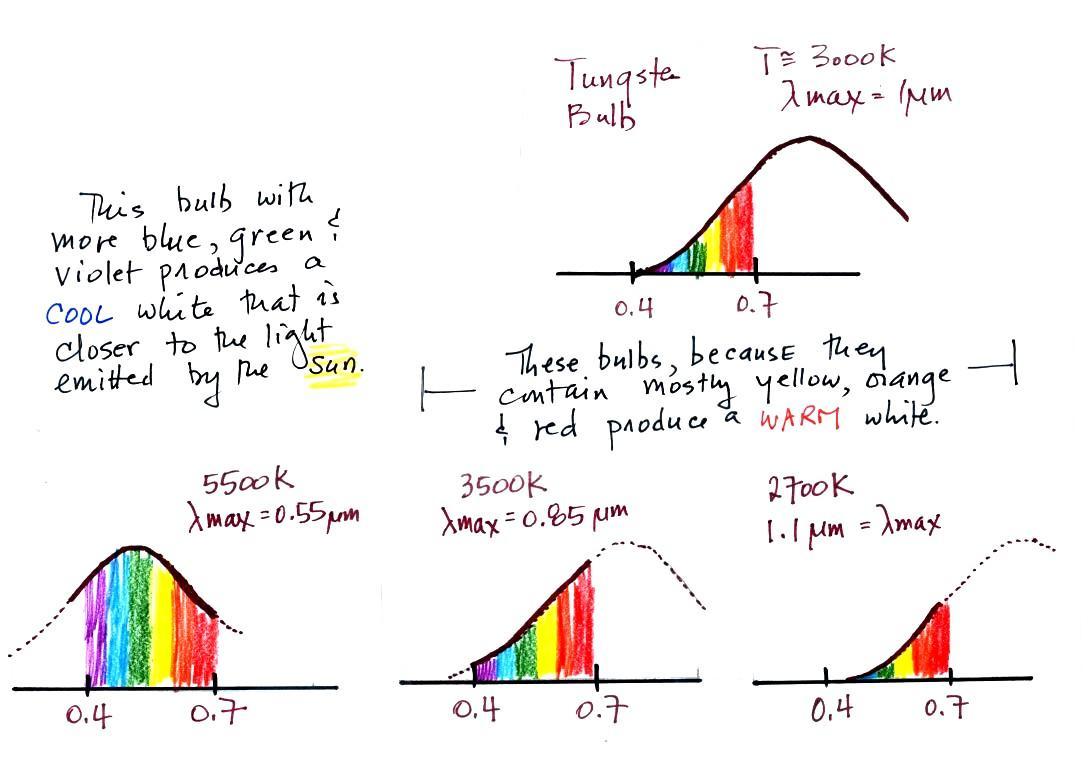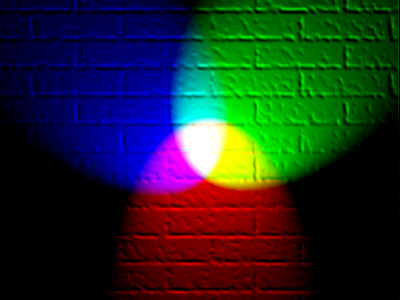Monday Mar. 3, 2014
I was reading about Lake Street Dive in the latest issue of
Rolling Stone this past weekend and thought I would feature one of
their songs "You
Go Down Smooth" before class today.
Both the 1S1P reports on Carbon Dioxide and the 1S1P Surface
Weather Map Analysis have been graded and were returned in class
today. A few people are within one report of reaching the 45
maximum number of points allowed for 1S1P reports. A sizable
number of students also have not earned any points yet. If
you're in the latter group I would suggest doing at least one of
the topics due this coming Wednesday.
The Experiment #2 reports were collected today. It takes a
while to get those graded so you can expect to get them back
sometime next week. The Experiment #1 revised reports are
due Wednesday this week. Please return the original report
with your revised report.
Here are the rules for the amount and kind (wavelength of
peak emission) of radiation emitted by an object. You don't
need to memorize them, I'll write them down whenever you might
need to use them. Most of today's class was devoted to
trying to understand or appreciate better what they mean.
The two graphs below (see the bottom of p. 65 in the
ClassNotes) are one way of doing that.
1.
Notice first
that both and warm and the cold objects emit radiation over a
range of wavelengths (the curves above are like quiz scores, not
everyone gets the same score, there is a distribution of
grades). The warm object emits all the wavelengths the
cooler object does plus lots of additional shorter wavelengths.
2.
The peak of
each curve is λmax the
wavelength of peak emission (the object emits more of that
particular wavelength than any other wavelength). Note
that λmax has
shifted toward shorter wavelengths for the warmer object.
This is Wien's law in action. The warmer object is
emitting lots of types of short wavelength radiation that the
colder object doesn't emit.
3.
The area
under the warm object curve is much bigger than the area under
the cold object curve. The area under the curve is the
total radiant energy emitted by the object. This
illustrates the fact that the warmer object emits a lot more
radiant energy than the colder object.
It is relatively easy to see Stefan-Boltzmann's law and Wien's
Law in action. The class demonstration consisted of an
ordinary 200 W tungsten bulb is connected to a dimmer switch (see
p. 66 in the photocopied ClassNotes). We'll be looking at
the EM radiation emitted by the bulb filament.
The graph at the bottom of p. 66 has been split up into 3
parts and redrawn for improved clarity.

We start with the bulb turned off (Setting 0). The
filament will be at room temperature which we will assume is
around 300 K (remember that is a reasonable and easy to remember
value for the average temperature of the earth's surface).
The bulb will be emitting radiation, it's shown on the top graph
above. The radiation is very weak so we can't feel
it. The wavelength of peak emission is 10
micrometers which is long wavelength, far IR radiation so we can't see
it.
Next we use the dimmer switch to just barely turn the bulb on
(the temperature of the filament is now about 900 K). The
bulb wasn't very bright at all and had an orange color.
This is curve 1, the middle figure. Note the far left end
of the emission curve has moved left of the 0.7 micrometer mark
- into the visible portion of the spectrum. That is what
you were able to see, just the small fraction of the radiation
emitted by the bulb that is visible light (but just long
wavelength red and orange light). Most of the radiation
emitted by the bulb is to the right of the 0.7 micrometer mark
and is invisible IR radiation (it is strong enough now that you
could feel it if you put your hand next to the bulb).
Finally we turn on the bulb completely (it was a 200 Watt
bulb so it got pretty bright). The filament temperature is
now about 3000K. The bulb is emitting a lot more visible
light, all the colors, though not all in equal amounts.
The mixture of the colors produces a "warm white" light.
It is warm because it is a mixture that contains a lot more red,
orange, and yellow than blue, green, and violet light. It
is interesting that most of the radiation emitted by the bulb is
still in the IR portion of the spectrum (lambda max is 1
micrometer). This is invisible light. A tungsten
bulb like this is not especially efficient, at least not as a
source of visible light.
You were able to use one of the diffraction gratings handed
out in class to separate the white light produced by the bulb
into its separate colors.
When you looked at the bright white bulb filament through one
of the diffraction gratings the colors were smeared out to the
right and left as shown at left below.
Some of the gratings handed out in class behaved a little
differently and spread out the colors horizontally, vertically,
and diagonally (right sketch above)
Next we had a look at the kinds of light emitted by the sun and
the earth.
The curve on the left is for the sun. We have used
Wien's law and a temperature of 6000 K to calculate λmax
and got 0.5 micrometers. This is green light; the sun
emits more green light than
any other kind of light. The sun doesn't appear green
because it is also emitting lesser amounts of violet, blue,
yellow, orange, and red - together this mix of colors appears
white (it's a cooler white than emitted by a
tungsten bulb). 44% of the radiation emitted by the sun is
visible light, Very nearly half of sunlight (49%) is IR
light (37% near IR + 12% far IR). 7% of sunlight is
ultraviolet light. More than half of the light emitted by
the sun (the IR and UV light) is invisible.
100% of the light emitted by the earth (temperature = 300 K) is
invisible IR light. The wavelength of peak emission for
the earth is 10 micrometers.
Because the sun (surface of the sun) is 20 times hotter
than the earth the sun's surface emits energy at a much higher
rate than the earth (160,000 times higher). Note
the vertical scale on the earth curve is different than on the
sun graph. If both the earth and sun were plotted with the
same vertical scale, the earth curve would be much too small to
be seen.
Ordinary tungsten bulbs (incandescent bulbs) produce a lot of
wasted energy. This is because they emit a lot of
invisible infrared light that doesn't light up a room (it will
warm up a room but there are better ways of doing that).
The light that they do produce is a warm white color (tungsten
bulbs emit lots of orange, red, and yellow light and not much
blue, green or violet).
Energy efficient compact fluorescent lamps (CFLs) are being
touted as an ecological alternative to tungsten bulbs because
they use substantially less electricity, don't emit a lot
of wasted infrared light, and also last longer. CFLs come
with different color temperature ratings.
The bulb with the hottest temperature rating (5500 K ) in the
figure above is meant to mimic or simulate sunlight
(daylight). The temperature of the sun is 6000 K and
lambda max is 0.5 micrometers. The spectrum of the 5500 K
bulb is similar.
The tungsten bulb (3000 K) and the CFLs with temperature
ratings of 3500 K and 2700 K produce a warmer white.
Three CFLs with the temperature ratings above were set up in
class so that you could see the difference between warm and cool
white light. Personally I find the 2700 K bulb "too warm,"
it makes a room seem gloomy and depressing (a student in class
once said the light resembles Tucson at night). The 5500
K bulb is "too cool" and creates a stark sterile atmosphere like
you might see in a hospital corridor. I prefer the 3500 K
bulb in the middle.
The figure below is from an
article on compact fluorescent lamps in Wikipedia for
those of you that weren't in class and didn't see the bulb
display. You can see a clear difference
between the cool white bulb on the left in the figure below and
the warm white light produced by a tungsten bulb (2nd from the
left) and 2 CFCs with low temperature ratings (the 2 bulbs at
right).
There is one downside to these energy efficient CFLs.
The bulbs shouldn't just be discarded in your ordinary household
trash because they contain mercury. They should be
disposed of properly (at a hazardous materials collection site
or perhaps at the store where they were purchased).
It probably won't be long before LED bulbs
begin to replace tungsten and CFL bulbs. The price has
dropped significantly in just the last 6 months or so.
LED stands for light emitting diode. We won't be
looking at them in detail except to say that a single LED can
produce only a single color, it can't produce white light.
What is done instead is to put three small LEDS producing red
green and blue light in close proximity. When they are
illuminated the three colors mix together to produce white
light.
The basic idea is shown below (the photo is from
Wikipedia)
Red green and blue light shining on a white surface.
You see white light were the three colors overlap and mix.
I'll try to do something like this in class on Wednesday
using green, red, and violet laser points.
As we have seen about 37% of sunlight is invisible near
infrared light. The world would not look the same if we were
able to see this near IR light instead of visible light.

|

|
visible light
reflected by the tree
and photographed with normal
film
|
near IR light
reflected by the tree
and photographed using near
IR film
|
The picture at left
was taken using normal film, film that is sensitive to
visible light. The picture at right used near
infrared film. In both pictures we are looking at
sunlight that strikes the tree or the ground and is reflected
toward the camera where it can be photographed (i.e. these
aren't photographs of visible light being emitted by the
tree or the ground).
The tree at left is green and relatively dark (it reflects
green light but absorbs the other colors of visible
light). The tree at right and the ground are white,
almost like they were covered with snow. The tree
and grass on the ground are very good reflectors of near
infrared light. Here are many
more images taken with infrared film.

Another example was shown in class, a thermal
image of a house. These are photographs of
infrared light that is being emitted (not reflected
light) by a house. Remember that the amount of energy
emitted by an object depends strongly on temperature (temperature
to the 4th power in the Stefan-Boltzmann law). Thus it is
possible to see hot spots that emit a lot of energy and appear
"bright" and colder spots. Photographs like these are often
used to perform an "energy audit" on a home, i.e. to find spots
where energy is being lost or leaking out of the house. Once
you locate one of these hot spots you can add insulation and
reduce the energy loss. Don't worry too much about the
colors. The photograph is probably taken using just a single
wavelength. The thing that varies is the intensity of the IR
light. Processing of the photograph adds color to make
differences in intensity more apparent. Reds and orange mean
more intense emission of IR radiation (warmer temperature) than
the blues and greens. We'll something similar when we look
at IR satellite photographs of clouds.














